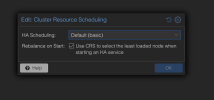Dear forum members,
I have encountered several questions regarding the operation of High Availability in Proxmox VE and would like to discuss them with you:
I would appreciate any ideas and solutions regarding these questions!
Sincerely,
Devis
I have encountered several questions regarding the operation of High Availability in Proxmox VE and would like to discuss them with you:
- Why does the pve-ha-crm failover process exceed a processing time of more than 60 seconds, with a significant increase in CPU usage? This leads to the loss of the master node and the inability to select a new master. What recommendations can you provide to address this issue?
- When initiating a failover, the hardware configuration is not taken into account, leading to memory and CPU overload on nodes when attempting to start the cluster. How can the cluster settings be optimized for better resource allocation?
- After the failover process, all virtual machines automatically start on the working servers, causing them to be overloaded in terms of memory and CPU. This may be related to how we allocate resources for virtual machines, and Proxmox may not adequately predict when loads reach their limits. How can we better organize resource allocation to avoid overloads?
I would appreciate any ideas and solutions regarding these questions!
Sincerely,
Devis


